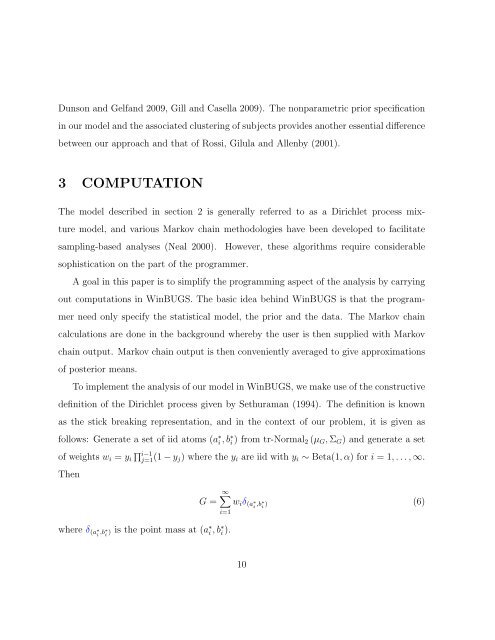Bayesian analysis of ordinal survey data using the Dirichlet process ...
Bayesian analysis of ordinal survey data using the Dirichlet process ...
Bayesian analysis of ordinal survey data using the Dirichlet process ...
You also want an ePaper? Increase the reach of your titles
YUMPU automatically turns print PDFs into web optimized ePapers that Google loves.
Dunson and Gelfand 2009, Gill and Casella 2009). The nonparametric prior specificationin our model and <strong>the</strong> associated clustering <strong>of</strong> subjects provides ano<strong>the</strong>r essential differencebetween our approach and that <strong>of</strong> Rossi, Gilula and Allenby (2001).3 COMPUTATIONThe model described in section 2 is generally referred to as a <strong>Dirichlet</strong> <strong>process</strong> mixturemodel, and various Markov chain methodologies have been developed to facilitatesampling-based analyses (Neal 2000).sophistication on <strong>the</strong> part <strong>of</strong> <strong>the</strong> programmer.However, <strong>the</strong>se algorithms require considerableA goal in this paper is to simplify <strong>the</strong> programming aspect <strong>of</strong> <strong>the</strong> <strong>analysis</strong> by carryingout computations in WinBUGS. The basic idea behind WinBUGS is that <strong>the</strong> programmerneed only specify <strong>the</strong> statistical model, <strong>the</strong> prior and <strong>the</strong> <strong>data</strong>. The Markov chaincalculations are done in <strong>the</strong> background whereby <strong>the</strong> user is <strong>the</strong>n supplied with Markovchain output. Markov chain output is <strong>the</strong>n conveniently averaged to give approximations<strong>of</strong> posterior means.To implement <strong>the</strong> <strong>analysis</strong> <strong>of</strong> our model in WinBUGS, we make use <strong>of</strong> <strong>the</strong> constructivedefinition <strong>of</strong> <strong>the</strong> <strong>Dirichlet</strong> <strong>process</strong> given by Sethuraman (1994). The definition is knownas <strong>the</strong> stick breaking representation, and in <strong>the</strong> context <strong>of</strong> our problem, it is given asfollows: Generate a set <strong>of</strong> iid atoms (a ∗ i , b ∗ i ) from tr-Normal 2 (µ G , Σ G ) and generate a set<strong>of</strong> weights w i = y i∏ i−1j=1(1 − y j ) where <strong>the</strong> y i are iid with y i ∼ Beta(1, α) for i = 1, . . . , ∞.Thenwhere δ (a ∗i ,b ∗ i ) is <strong>the</strong> point mass at (a ∗ i , b ∗ i ).∞∑G = w i δ (a ∗i ,b ∗ i ) (6)i=110
















